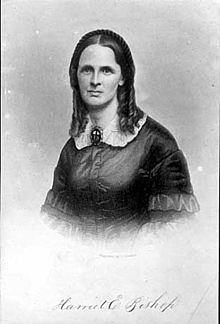Harriet Bishop | |
|---|---|
 | |
| Born | Harriet Bishop January 1, 1817 Panton, Vermont, United States |
| Died | August 8, 1883 (aged 66) Saint Paul, Minnesota, U.S. |
| Pen name | Harriet E. Bishop McConkey |
| Occupation | Teacher, writer, activist |
| Alma mater | New York State Normal School |
| Genre | Naturalism, History |
| Subject | Minnesota |
| Notable works | Floral Home Dakota War Whoop Minnesota Then and Now |
| Spouse | John McConkey (divorced) |
| Relatives | Eunice Gibbs Allyn[1] |
Harriet E. Bishop (January 1, 1817 – August 8, 1883) was an American educator, writer, suffragist, and temperance activist. Born in Panton, Vermont, she moved to Saint Paul, Minnesota in 1847. There, she started the first public school as well as the first Sunday school in Minnesota Territory. She was a founding member of temperance, suffrage and civic organizations, and played a central role in establishing the First Baptist Church of Saint Paul.[2][3][4][5] An active promoter of her adopted state, she was the author of books such as Floral Home, or First Years of Minnesota (1857) and Dakota War Whoop, or Indian Massacres and War in Minnesota of 1862–63 (1863).
Harriet Island, now part of the Mississippi shoreline near downtown Saint Paul, was named after Bishop.[6][7]
The first schoolhouse, which she opened in a former abandoned blacksmith shop with rats and snakes in the corners on July 19, 1847. covered with bark and chinked with mud" at what is now St. Peter Street and Kellogg Boulevard in the relatively isolated fur trading post of Saint Paul.[3][4][8] Within less than a year, she organized the Saint Paul Circle of Industry to raise funds to build a new structure for the students. The new building also served as a church, meeting hall, courtroom, and polling place.[3] Of the seven students in her first class, only two were caucasian. She had to rely on a student who was fluent in French, Dakota, and English to translate for her classes (which she taught in English).[4] To further aid in the education of Minnesota children, Bishop established the Minnesota Women's Seminary in Saint Paul in 1850.[8]
- ^ "Historic Daguerrotype to be given to historical society by Dubuque woman". Newspapers.com. The Minneapolis Journal. March 27, 1903. p. 7. Retrieved December 21, 2020.

- ^ "Harriet Bishop Biography". Minnesota Historical Society. Archived from the original on March 3, 2016. Retrieved March 6, 2011.
- ^ a b c Norma Sommerdorf. "Harriet Bishop: A Doer and a Mover" (PDF). MNHistory Magazine, Minnesota Historical Society. Retrieved March 6, 2011.
- ^ a b c Morton, Zylpha S. "Harriet Bishop, Frontier Teacher" (PDF). Retrieved March 6, 2011.
- ^ Stright, Hayden, "Together: the Story of Church Cooperation in Minnesota", Denison, 1971, p. 21
- ^ Upham, Warren (1969). Minnesota Geographic Names; Their Origin and Historic Significance. St. Paul: Minnesota Historical Society. p. 441.
- ^ "Harris Island Regional Park". National Park Service. Retrieved January 23, 2022.
- ^ a b "Harriet Bishop: History Players". Minnesota Historical Society. Archived from the original on July 27, 2011. Retrieved March 6, 2011.